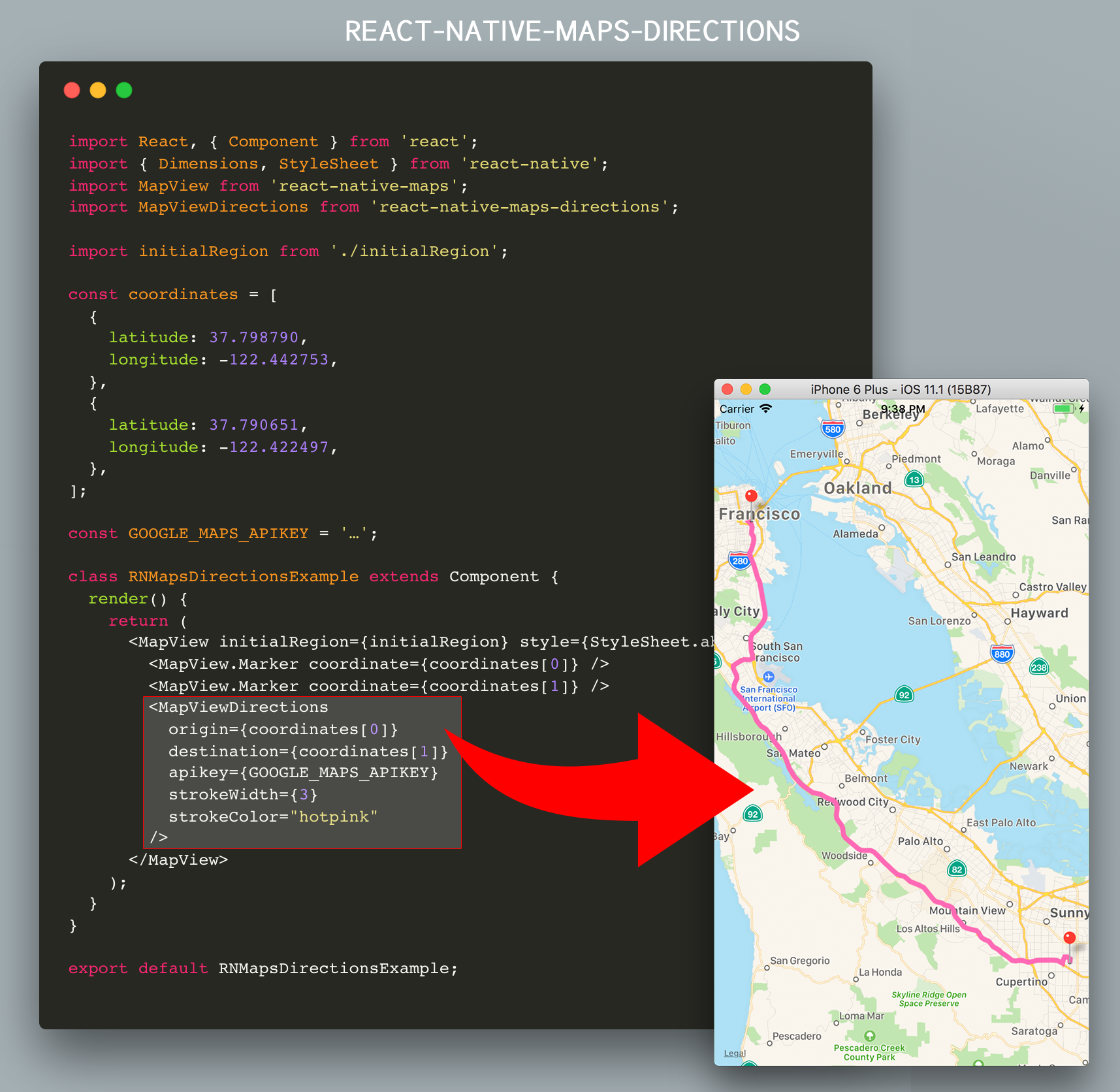react-native-maps-directions-battere
v1.4.24
Published
Directions Component for react-native-maps
Downloads
11
Maintainers
Readme
react-native-maps-directions 
Directions component for react-native-maps – Draw a route between two coordinates, powered by the Google Maps Directions API

Installation
yarn add react-native-maps-directionsBasic Usage
Import MapViewDirections and render it as a child of a MapView component. The mandatory MapViewDirections props are:
origin: The coordinate of the origin locationdestination: The coordinate of the destination locationapikey: Your Google Maps API Key (request one here).
import MapViewDirections from 'react-native-maps-directions';
const origin = {latitude: 37.3318456, longitude: -122.0296002};
const destination = {latitude: 37.771707, longitude: -122.4053769};
const GOOGLE_MAPS_APIKEY = '…';
<MapView initialRegion={…}>
<MapViewDirections
origin={origin}
destination={destination}
apikey={GOOGLE_MAPS_APIKEY}
/>
</MapView>Once the directions in between destination and origin has been fetched, a MapView.Polyline between the two will be drawn.
Component API
Props
| Prop | Type | Default | Note
|---|---|---|---|
| origin | LatLng or String | | The origin location.
| destination | LatLng or String | | The destination location.
| apikey | String | | Your Google Maps API Key (request one here).
| waypoints | [LatLng or String] | | Array of waypoints to use between origin and destination.
| language | String | "en" | The language to use when calculating directions. See here for more info.
| mode | String | "driving" | Which transportation mode to use when calculating directions. Allowed values are "driving", "bicycling", "walking", and "transit". (See here for more info).
More props
Since the result rendered on screen is a MapView.Polyline component, all MapView.Polyline props – except for coordinates – are also accepted.
<MapView initialRegion={…}>
<MapViewDirections
origin={origin}
destination={destination}
apikey={GOOGLE_MAPS_APIKEY}
strokeWidth={3}
strokeColor="hotpink"
/>
</MapView>An extra note on origin and destination
origin and destination can be coordinates in the form of objects with latitude and longitude keys, or coordinates in the form of a string in the format 'latitude,longitude'.
<MapViewDirections origin={{ latitude: 37.3317876, longitude: -122.0054812 }} … />
<MapViewDirections origin="37.3317876,-122.0054812" … />Additionally origin and destination can also be location names. The Google Directions API will translate those to coordinates for you.
<MapViewDirections origin="Apple Park Visitor Center, Cupertino, CA, USA" … />Don't forget to tweak the language prop when using localized location names.
Events/Callbacks
| Event Name | Returns | Notes
|---|---|---|
| onReady | { distance: Number, duration: Number, coordinates: [] } | Callback that is called when the routing has been calculated.
| onError | errorMessage | Callback that is called in case the routing has failed.
Extended Example
This example will draw a route between AirBnB's Office and Apple's HQ
import React, { Component } from 'react';
import { Dimensions, StyleSheet } from 'react-native';
import MapView from 'react-native-maps';
import MapViewDirections from 'react-native-maps-directions';
const { width, height } = Dimensions.get('window');
const ASPECT_RATIO = width / height;
const LATITUDE = 37.771707;
const LONGITUDE = -122.4053769;
const LATITUDE_DELTA = 0.0922;
const LONGITUDE_DELTA = LATITUDE_DELTA * ASPECT_RATIO;
const GOOGLE_MAPS_APIKEY = '…';
class Example extends Component {
constructor(props) {
super(props);
// AirBnB's Office, and Apple Park
this.state = {
coordinates: [
{
latitude: 37.3317876,
longitude: -122.0054812,
},
{
latitude: 37.771707,
longitude: -122.4053769,
},
],
};
this.mapView = null;
}
onMapPress = (e) => {
this.setState({
coordinates: [
...this.state.coordinates,
e.nativeEvent.coordinate,
],
});
}
render() {
return (
<MapView
initialRegion={{
latitude: LATITUDE,
longitude: LONGITUDE,
latitudeDelta: LATITUDE_DELTA,
longitudeDelta: LONGITUDE_DELTA,
}}
style={StyleSheet.absoluteFill}
ref={c => this.mapView = c}
onPress={this.onMapPress}
>
{this.state.coordinates.map((coordinate, index) =>
<MapView.Marker key={`coordinate_${index}`} coordinate={coordinate} />
)}
{(this.state.coordinates.length >= 2) && (
<MapViewDirections
origin={this.state.coordinates[0]}
waypoints={ (this.state.coordinates.length > 2) ? this.state.coordinates.slice(1, -1): null}
destination={this.state.coordinates[this.state.coordinates.length-1]}
apikey={GOOGLE_MAPS_APIKEY}
strokeWidth={3}
strokeColor="hotpink"
onReady={(result) => {
this.mapView.fitToCoordinates(result.coordinates, {
edgePadding: {
right: (width / 20),
bottom: (height / 20),
left: (width / 20),
top: (height / 20),
}
});
}}
onError={(errorMessage) => {
// console.log('GOT AN ERROR');
}}
/>
)}
</MapView>
);
}
}
export default Example;Changelog
Please see CHANGELOG for more information on what has changed recently.
Credits
- Bram(us) Van Damme (https://www.bram.us/)
- All Contributors
This code is inspired upon the article React Native Maps with Google Directions Api by Ali Oğuzhan Yıldız.
License
The MIT License (MIT). Please see License File for more information.
